With amazing food, stunning scenery, friendly people, a lyrical language and awe-inspiring architecture, what is there not to love about Italy? Wherever you go, there seems to be an Italian castle, palazzo or magnificent villa to wander around. Italy is full of castles, palazzos and fortresses. Sadly some have fallen into disrepair, while others have been converted into museums.
Come and explore 25 of the best castles in Italy recommended by fellow bloggers including some of my personal favourites.
*This site uses affiliate links and I may earn a small commission when you use my links and make a purchase without incurring an additional fee yourself.
Thank you for supporting this website. See my disclaimer page for more details.
Best Castles in Northern Italy
Rocca Sforzesca, Imola
Contributed by Larch from The Silver Nomad

Near the centre of Imola stands the medieval castle of Rocca Sforzesca. The impress castle 13th Century castle was originally built with square towers, one of which is still visible. Other remains that can still be seen include the pointed archway above the entrance doorways and the dungeons under each of the four round towers. In the mid-1400s the fortress was reinforced to counter assaults by firearms.
The drawbridge over the now-dry moat leads you to the entrance of the castle. After renovations, Rocca Sforzesca reopened in 1973 as a museum with an impressive collection of weaponry and ceramics.
You can also visit the dungeons, walk around the courtyard and the upper terrace for amazing views over the town of Imola and the surrounding countryside.
The International Piano Academy “Incontri col Maestro”, also has its Head Offices in the rear of the castle.
There is parking in front of the castle and a café opposite.
The Rocca Sforzesca is open on Fridays, Saturdays, and Sundays. The entrance fee is €4 and free admission for Bologna Welcome Card owners.
Address: Piazzale Giovanni Dalle Bande Nere – 40026 Imola
Fortezza di Montalcino, Tuscany
Contributed by Hannah from That Adventurer
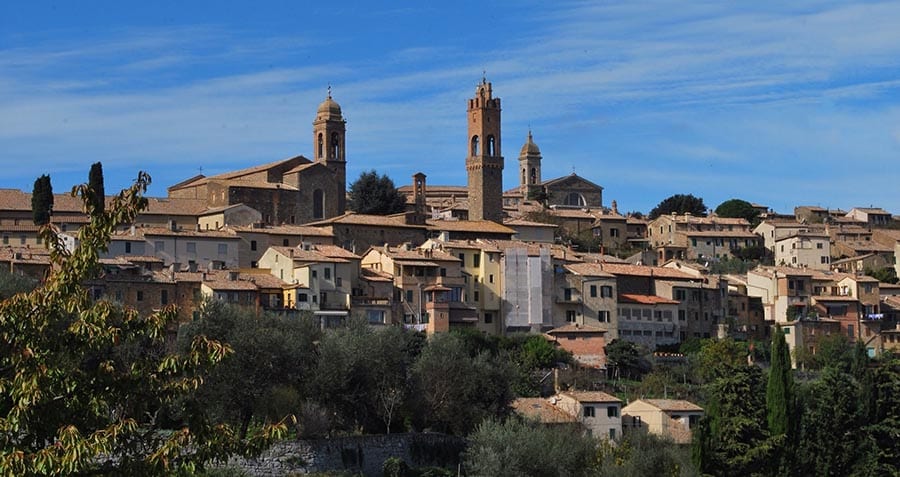
Montalcino is one of the most beautiful hilltop towns in Tuscany. 42km away from the city of Siena, Montalcino sits upon a hill and is still protected by the walls of the Fortezza di Montalcino, or the fortress of Montalcino. The huge walls of the fortress have been very well preserved and offer you a chance to explore a piece of Tuscan history. Built in 1361, the walls enclose Montalcino in a pentagonal design and the 14th Century fortress dominates the town centre.
The fortress of Montalcino protected the town which aligned itself with Siena during the power struggles between Siena and Florence from the 12th Century onwards. While the town was caught in the crossfire and eventually conquered, the fortress was never taken and thus maintains the original walls in a great condition.
It’s free to enter the fortress grounds but if you wish to climb up to the ramparts and stroll along the top taking in the Tuscan countryside views you’ll need to purchase a ticket for 3€50.
In the summer, the fortress becomes a unique setting for festivals and concerts including the Jazz & Wine Festival in July. Outside of the festivals, the tower is home to many enoteca (wine bars) serving the Brunello di Montalcino red wine that Montalcino has become famous for.
There are many tours of Tuscany that will make a stop at Montalcino. Otherwise, if you’re coming from Florence or Siena, then head south on the Raccordo Autostradale Firenze – Siena, the SR2 south of Siena and then follow signs up the hill to Montalcino.
D’Alberis Castle, Genoa

Contributed by Paul from The Two That Do
Unlike many of the other iconic castles detailed here D’Alberis Castle in Genoa does not boast centuries of history. Constructed at the end of the 19th century by mariner and sea-explorer Enrico Alberto D’Albertis this Castle is just 120 years old.
However, D’Albertis did build the Castle that still bears his name on the site of a former 13th-century fort and his Gothic design does incorporate these original foundations and a later 16th-century turret.
Its 1892 inauguration designed to coincide with the 400th anniversary of the discovery of America by Christopher Colombus, the most famous Genovese mariner and explorer.
Located atop Monte Galletto hill visitors are able to reach the Castle via a unique horizontal and vertical elevator. This is accessed directly from Via Balbi no more than 100 metres east of the Christopher Colombus monument in front of Genoa’s Principe Train Station.
As you approach the Castle through the lush floral gardens your eye will inevitably be distracted by the magnificent views over Genoa toward the deep blue Ligurian Sea stretching out to the horizon.
After his death in 1932 D’Alberis Castle was donated to the city of Genoa and is now home to the Museum of World Cultures. For an entry fee of just €6.00 for adults and €4.50 for children or those over 65 years of age visitors will be treated to a unique collection of items and memorabilia brought home by D’Albertis from his explorations to America, Africa and Oceania.
YOU MAY ALSO LIKE: Best Weekends in Italy
Miramare Castle, Trieste
Contributed by Larch from The Silver Nomad

The stunning white Miramare Castle stands looking out across the Gulf of Trieste. Built in the 19th Century for Archduke Ferdinand Maximilian of Habsburg and his wife Charlotte of Belgium.
The style of the castle is a mixture of Gothic, Renaissance, and medieval and is set in 22 hectares of beautiful gardens dotted with sculptures, small lakes, and exotic flowers.
The castle has been a state museum since 1955. Visitors to the castle are taken on a guided tour of rooms with displays 19th-century furnishings, artwork, and decor. Of special interest are Maximilian’s Rooms, which include the bedroom, furnished as a ship’s cabin, and the “Throne Room”.
The castle is open every day from 9.00 am to 7.00 pm except Christmas Day and New Years Day. Entrance to the Castle is €12. Entrance to the Park is free. For more information see the Miramare Castle website.
Try The Intrepid Italian language course if you want to learn some common Italian phrases for travelling like a local
Buonconsiglio Castle, Trento
Contributed by Jonathan from Journey Maxx

The residence of the Prince-Bishops of Trento from the 12th Century to 1803, Buonconsiglio Castle open to the public today serves as a museum, exhibition and garden.
Entering through the main door entrance takes you first into what feels like your own enchanted secret garden with roses lined up along the walls. The Castelvecchio (Old Castle) is as the name suggests the oldest and first part of the castle with the extra Magno Palazzo added during the Renaissance period.
Perhaps the most striking characteristic of Buonconsiglio Castle has to be the immaculately painted frescoes that adorn the walls. Notably in the Loggia del Romanino section complemented by the ever-fascinating Venetian Gothic arches around it and looking out towards some of the best views you will get of Trento and to the mountains beyond. The preservation of the wall and ceiling art is so delicate and admirable.
In part of the main castle is the Torre Aquila, location of the “Cycle of the Months” frescoed paintings dating back to the Middle Ages and depicting a typical year in the life of Trento and its people for each month of the year.
Entrance is €10 and that also includes the museum within the castle that includes numerous paintings and artefacts. Access to the gardens is free, however.
Scaliger Castle in Malcesine
Contributed by Or from My Path in the World
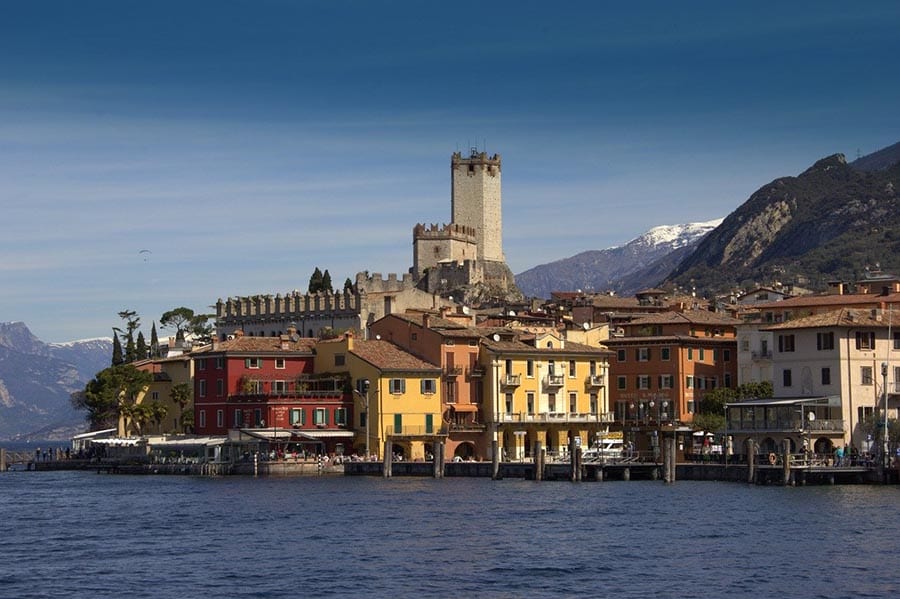
Malcesine is one of the most beautiful towns to visit when going on a road trip through northern Italy, and one of its highlights is, without a doubt, the Scaliger Castle (Castello Scaligero). Not only is it a stunning historical landmark, but it is also where you’ll get insta-worthy panoramic views of the most colourful town on Lake Garda.
Surprisingly, some sources say that the original castle was built during the first millennium B.C, but most of the structures standing today date back to the 13th and 14th centuries, when the castle was ruled by the Della Scala family (hence the name). Since then, it had quite a few owners throughout history, and in 1902, it was declared a national monument.
Today, for only 6 Euros, you can visit the castle, which is open daily (even during the winter months). Apart from wandering through its courtyards and climbing up to the tower to get a super scenic 360-degree view over Malcesine, there are a few more things to do inside the castle.
These include visiting the Natural History Museum of Mount Baldo and Lake Garda, seeing the drawing exhibition dedicated to the writer Johann Wolfgang von Goethe, and visiting the Museum of the Venetian Galleys.
Castello dei Vicari, Lari, Tuscany
Contributed by Paulina from Paulina on the Road

Built on the top of a hill in a quiet little province of Pisa in the early medieval times is Castello dei Vicari, Lari in Tuscany. The castle stands on a privileged position on the Arno Valley. You have to take a walk in which you pass gates built thousands of years ago to reach there. As you reach the top of the castle, you will find yourself in its courtyard.
From there, you could see a spectacular 360-degree view of the surrounding valley and the farms. Also, on a clear sunny day, you will be able to catch the sea’s blue colour far in the distance. In 1406 the castle fell into the hands of Florentine. As a result, the whole place got some serious facelift. After that, noble families have resided in the castle and have called it their home.
The Vicari is the french name for Florentine governors, local power in the area. To enter the castle, you need to pay just 4 Euros, and the earliest opening of the castle is at 10:15 Am and the closing time is 6:00 Pm, but the time keeps on changing depending on the month.
Thus, you should talk to the locals before taking a trip. Lastly, if you are in the province, make sure you get your hands on the cotton made products as it is famous for residing some of the well known organic cotton brands from Europe.
Barolo Castle, Piedmont
Contributed by Larch from The Silver Nomad

The wine region of Langhe, Roero, and Monferrato is part of the UNESCO World Heritage Sites. Barolo Castle which looks out over the rolling vineyards is not one but actually two castles: Castello Falletti (the communal castle) and the Castello della Volta.
In the 10th Century, it is believed that Castello Falletti was built as a way of defending the commune, of which only the keep remains. In the 13th Century a deed granting the building to the commune of Alba was the first written evidence of the fortress’ existence. It was then transferred to Falletti family who rebuilt is as a home for the family. In 1524 there are 30 houses recorded around the castle, which were then removed to make the castle larger.
It stayed as a country residence in the Falleti family until the death of the Marchesa Faletti in 1864. After her death is was converted into the Collegio Barolo under the ownership of the Opera Pia Barolo giving education to the economically disadvantaged.
In 1970 the Commune of Barolo bought the castle raised funds, mainly form local citizens to restore the building. It was at this time that the Castello was converted to house the Enoteca Regionale del Barolo, the Wine Museum of Barolo.
The Enoteca Regionale del Barolo, the Wine Museum of Barolo, is entirely dedicated to the Barolo wines, which were first created in the castle’s cellars. It give you an insight into the centuries-old tradition of winemaking in the region.
There guided tour of the which takes around 30 minutes leads you up and down the five floors through the rooms to see the 16th Century stucco work, the Empire-style beds, the library and the dining-room with interactive plates showing typical dishes of the times. The Museo Etnografico-Enologico is part of the tour with kaleidoscopic images and views of the region.
Don’t miss the panoramic views from upper terrace over the far-reaching rolling hills of the Lange.
At the end of the tour, take part in some tasting of the delicious Barolo wines, considered to be “king of wines” and maybe take a few home with you.
Castelvecchio, Verona
Contributed by Michele from The Intrepid Guide
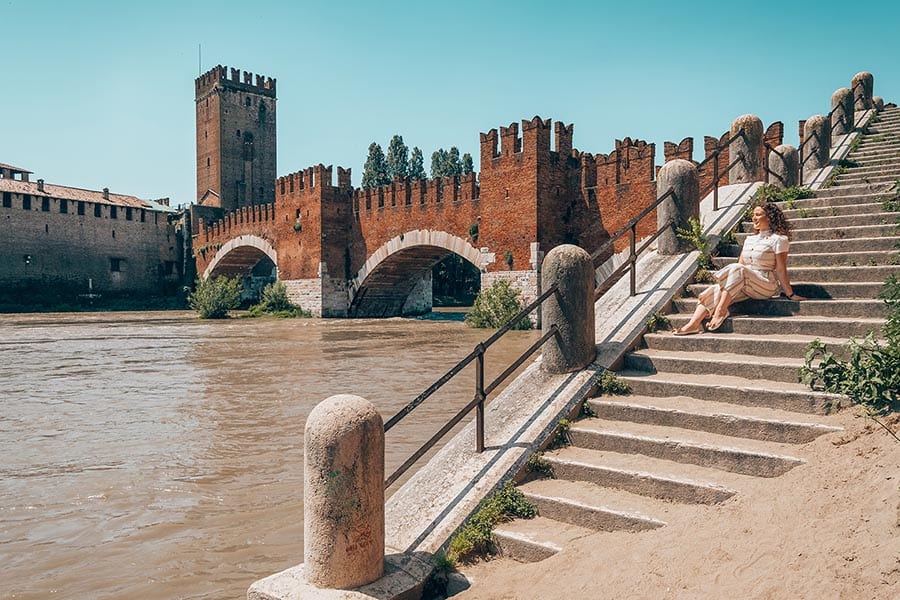
Castelvecchio and Castelvecchio Museum and Gallery, Verona One of the best things to do in Verona is to visit Castelvecchio. Built in 1354 by Cangrande II della Scala of the Scaliger clan who ruled Verona in the Middle Ages, the moated fortress was designed to protect the family in case of revolt.
This square-shaped fort dominates the banks of the River Adige and was the most powerful military construction in the area during the Middle Ages.
Today, the castle is now home to the Castelvecchio Museum and Gallery where you can trace the castle’s long history. Your ticket also gives you access to the two guard towers which have wonderful views over “fair Verona” city centre and river.
Address: Corso Castelvecchio, 2, 37121 Verona – Just a 7 minute walk from Piazza Bra and Verona Arena.
Opening hours:
Castelvecchio Museum and Gallery is open daily:
- Tuesday – Sunday: 08:30 – 19:30 (the ticket office closes at 18:45)
- Monday: 13:30 – 19:30 (the ticket office closes at 18:45)
Admission: Entrance is free with the Verona Card or for persons with disabilities, otherwise adults are 6,00 € and a reduced ticket is 4,50 €.
Scaligero Castle, Sirmione
Contributed by Dymphe from Dymabroad

When you go to Lake Garda, and more specifically the little town of Sirmione, you should definitely see Scaligero Castle! It is an old fortress dating from the 13th century during the time when Verona ruled over the area. It is one of the most preserved and most interesting castles in Italy.
What’s interesting about the castle is that it is the only gateway to the town of Sirmione. To enter the town you have to go through the gate of the castle. This is because the town of Sirmione is located on a peninsula with the castle between the town and the strip of land leading to the town.
If you want to see more than just the outside and the gate, then you can visit the museum. Here you’ll learn more about the history of the castle, and you can access many parts of the castle and you can even go to the highest tower of the castle! From this highest point, you have a great overview over the town of Sirmione.
The fee to get inside of the castle is 6 euros. Furthermore, to get to the town of Sirmione, and thus the castle, you can take the bus, use your own car, or go by ferry. Also, if you’re looking for more amazing places in Italy, you should definitely visit some of the best cities in Italy
Borgo Castle, Gorizia
Contributed by Larch from The Silver Nomad

The 11th Century Borgo Castle in Gorizia sits up on the hill overlooking the town. Passing through the 17th Century Porta Leopoldina archway the road climbs up past the Museums of World War I and the Museum of the Fashion and Applied Arts to reach the castle.
The castle has been added to over the centuries, including some of the bastions designed by Edmond Halley (of the eponymous comet) in the 17th Century.
After being bombed heavily in World War I, the castle was rebuilt in 1937 and now houses a museum to the Middle Ages, with the rooms set out as they would have been with medieval furniture, paintings, sculpture and busts and tapestries. There is also a display of reproduction of musical instruments from the time. You can listen to recordings as you walk through the Sala della Musica.
Climb to the ramparts for amazing 360 views of Gorizia and into neighbouring Nova Gorica in Slovenia.
Entry to the castle is full price ticket € 3.00; reduced price ticket € 1.50 (6-24 year, over 65s) or free with an FVG Card
Castello Sforzesco, Milan
Contributed by Katy from Untold Travel

Dominating central Milan, Castello Sforzesco is the city’s famous fortress. Built by the ruling Visconti and Sforza families over several centuries,the castle is an impressive castle with watch towers, fountains and even a drawbridge.
Once one of the biggest citadels in Europe, the castle wasseriously damaged in the allied bombings on Milan towards the end of World War II. It has since been restored and is now home to several interesting museums and galleries featuring culturally important items and artwork from the city’s history.
While the collections showcase the city’s collections of weaponry, furniture, musical instruments, art, and sculpture, the main highlights of museums inside the castle complex are by Renaissance masters. There are paintings by Canaletto, Tiepolo, Vincenzo Foppa, Titian and Tintoretto in the Pinoteca gallery. This is a small gallery, and much less crowded than those in Florence and Rome, so you can spend some time appreciating the artwork.
Finally do not miss Michelangelo’s last unfinished Rondanini Pietà statue and the remains of Leonardo da Vinci’s stunning fresco in the Sala delle Asse. Despite being constantly undergoing conservation work, you can appreciate the detail and talent of the artist in this huge outdoor scene that dominated the castle’s main reception area.
There is no charge to explore the exterior and central courtyards but it is definitely worthwhile spending €5 to visit the museums inside.
Castle of the Princes of Acaja, Fossano
Contributed by Lyndsay from The Purposely Lost

In the center of the small Piemonte town of Fossano is a beautiful Medieval castle. The Castle of the Princes of Acaja was built by Filippo d’Acaia and completed in 1332. Conceived initially to be a fortress as part of a commitment by the townspeople to be protected from outsiders, 100 years later, it was turned into a ducal residence.
Later, the castle was transformed into the area’s prison and barracks. Today, the castle serves a new purpose year-round at Fossano’s public library.
Every summer, the castle is transformed into the center of Fossano’s palio. There’s a parade through the streets, with locals wearing historically accurate Medieval dress that ends at the castle. And, the area outside of the castle becomes a dirt track and performance space. The town is separated into four teams, and each team competes against each other in archery and horseracing events.
If you’re interested to see inside the castle, head into the library portion to catch a glimpse of some interior rooms today, or climb to the top of one tower for views of the city below. You can even check with the Fossano tourist information office located right inside the courtyard if they’re hosting a free tour in English the day you visit.
Castello di Malpaga in Cavernago, Lombardy, Italy
Contributed by Audrey from That Backpacker
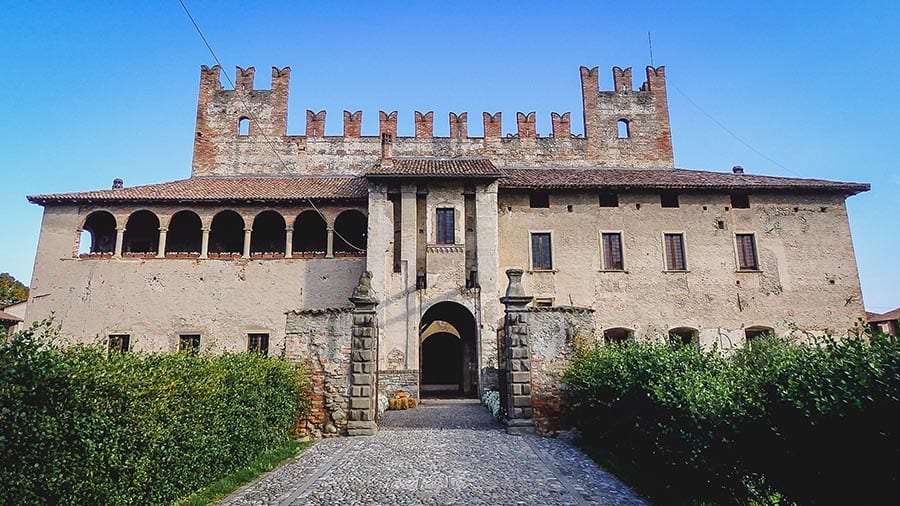
Situated in the comune of Cavernago, just 14 kilometres southeast from the city of Bergamo, you’ll find Castello di Malpaga. This is considered to be one of the finest castles to visit in the Lombardy region and it makes for a really fun day trip.
To give you a bit of history, in 1456, the ruins of this early medieval castle were acquired by the Captain-General of the Republic of Venice Bartolomeo Colleoni. He decided to make this his private residence, but first, he set out to improve the castle’s defences by raising its walls, adding a second moat and building a military base for his troops.
Colleoni had earned great wealth and power fighting other people’s battles, and this meant he had a lot of enemies. In fact, so many people were after Colleoni that he had to take many precautions to stay alive: he slept seated in bed so that he would be ready to leap and fight should an intruder come in, he purposely slept in a room without a chimney lest someone sneak in to kill him, and he also had a group of food tasters to ensure his food hadn’t been poisoned.
The best way to reach this castle is by car, or alternatively, you can take bus #93 (Bergamo – Via Borgo Palazzo), where you’ll get off at Malpaga – Bivio Palazzo and walk about a kilometre to the gates.
Malpaga Castle opens its doors and welcomes visitors every weekend from March to November. It is currently possible to do an audio-guided tour where you can meander through the castle grounds while listening to stories that unfolded within these walls. The cost of admission is €10 if you download the audioguide app on your phone, or €15 if you need to rent an audioguide.
It is also possible to stay in the castle at the Locanda dei Nobili Viaggiatori, where the 5 bedrooms are named after kings and dukes who stayed as guests during Bartolomeo Colleoni’s life.
Rocchetta Mattei in Grizzana Morandi, Bologna
Contributed by Lori from Travelinmad.com
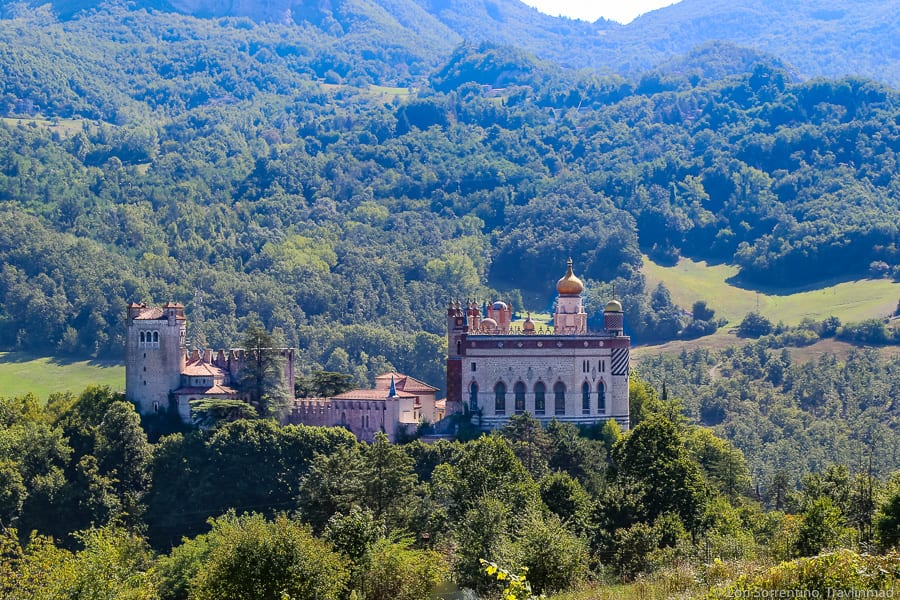
In the midst of the verdant green hills of the Bologna Apennines near Grizanna Morandi, Italy lies a magnificent Moorish and medieval-style castle straight out of a fairytale. Rocchetta Mattei is a quirky structure seemingly out of place in the rural landscape, and its history is as colourful as the castle itself.
The eccentric Earl Cesare Mattei and founder of electro-homoeopathy, a medical therapy based on re-establishing a natural body balance using the therapeutic power of “electricity” found in herbal remedies, built the Rocchetta around 1859.
Over the years he used it as a treatment facility for patients he treated for free, and the Count died here in 1896. So well regarded was he that even Fyodor Dostoevsky mentioned him in his novel The Brothers Karamazov.
Today, a visit to Rocchetta Mattei is a must when you visit Bologna. The castle itself is built on a large rock overlooking the surrounding valley, though it sits right along the road so the main site is the castle interior and not the grounds.
The castle itself is more funhouse than fairytale, and with each step you take down the maze of staircases, halls, and hidden rooms around every corner you’ll find yourself more curious about Mattei himself and his unconventional healing practices.
It’s an easy one-hour drive from the city to the castle if you follow the Porrettana street number 64. The castle is open for guided tours only on weekends, and advance reservations are needed. Tickets cost around €10.
Castello Estense, Ferrara
Contributed by Dhara from It’s Not About the Miles
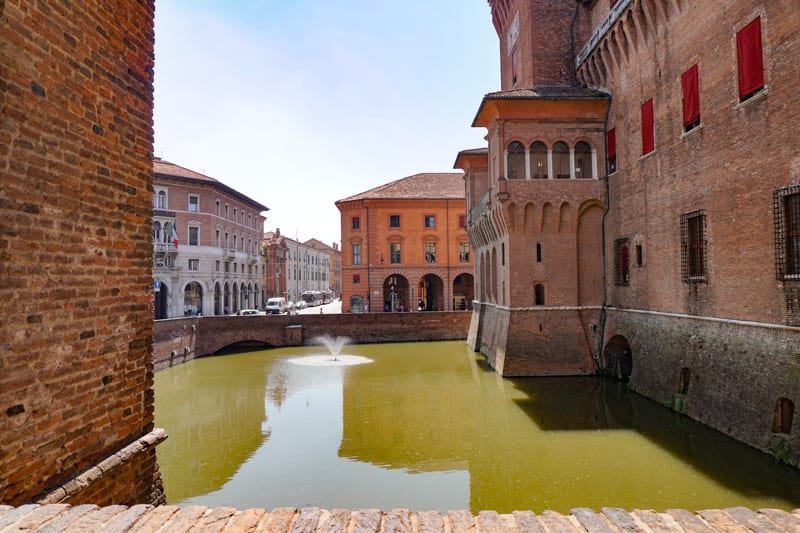
One of the top things to do in Ferrara, Italy, is a tour of the magnificent Castello Estense. Unlike other castles, this one sits right in the historical center, so it’s both easy and convenient to visit.
The Este Castle was built by Marquis Niccolò II d’Este in the late 14th century, after a revolt by the Ferrarese people convinced the Marquis that he could no longer live safely in his palace. The courtyard even contained wells for water supply.
After the Est family left Ferrara for Modena, the castle was used by the Papal Legate. In 1860, when Ferrara became part of the Kingdom of Italy, the castle was taken over by the government. The fortified castle, with four towers and a moat and drawbridges, is a fascinating place to tour.
The exterior of the palace belies the opulent interior, with beautiful frescoed and carved ceilings. The Hall of Games has a gorgeous ceiling, where a number of games and sports are portrayed in frescoes. Sadly, the frescoes have had to be taped after earthquake damage.
Inside you will also find the Ducal Chapel, a beautifully frescoed chamber with marble walls. Stroll the Courtyard of Oranges, which smells divine when the citrus is in bloom. Finally, look out from the tower over the rooftops of Ferrara: the views are stunning.
There is a fee of 12 Euros per adult to visit the Castello Estense.
Best Castles in or near Rome
Castel Sant’Angelo, Rome
Contributed by Katy from Our Escape Clause
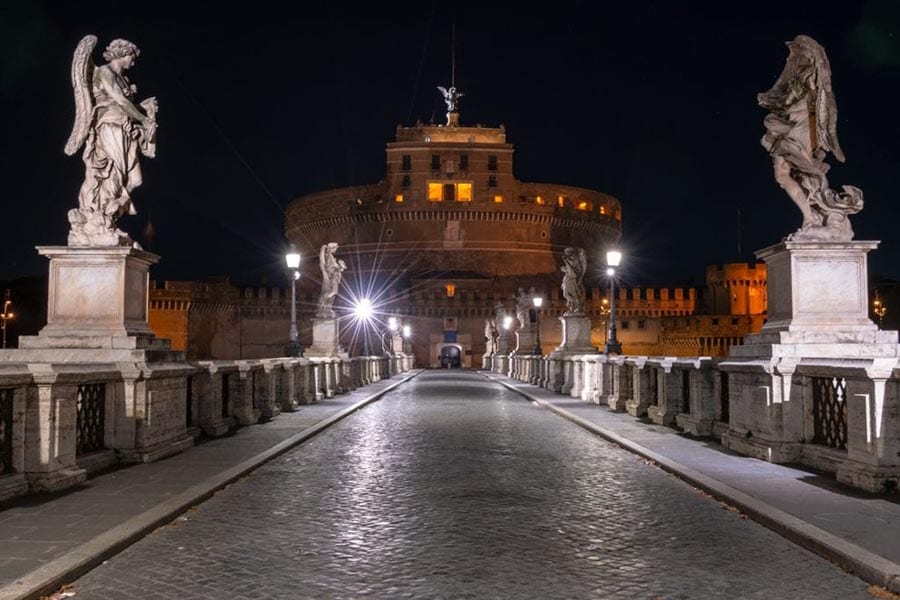
Located in the heart of Rome, Castel Sant’Angelo has a nearly 2000-year-old history dotted with time spent as a fortress, a prison, a secret escape route, and mausoleum–in other words, in a city of remarkable history, the Castel Sant’Angelo still manages to stand out.
Castel Sant’Angelo, with its distinct cylindrical shape that has been compared to a wedding cake, started life as a mausoleum for the Emperor Hadrian and his family.
Later – meaning the 400s – it was converted into a military fortress.
Fast forward another 1000 years or so, and in the 14th century, Castel Sant’Angelo was given yet another purpose in life by being converted into a fortress for popes – it’s no coincidence that you can see St. Peter’s Basilica from the top of Castel Sant’Angelo!
In the 14th century, the Passetto di Borgo was built–the secret passage leading between Vatican City and the Castel Sant’Angelo (this passage was a plot point in the book and movie Angels & Demons). In 1527, Pope Clement VII famously used the passage to successfully escape the city during that year’s sack of Rome.
Today, visitors can tour the interior of Castel Sant’Angelo, uncovering the many layers of history that reside in the building. The rooftop also happens to be home to one of the best views of Rome!
Tickets to visit the Castel Sant’Angelo are currently 20 Euro for non-EU residents. It is right across the Tiber from Centro Storico and less than a 10-minute walk from St. Peter’s Basilica, making it easy to access when visiting Rome.
YOU MIGHT ALSO LIKE: 35+ Amazing Hidden Gems in Europe you must visit
Bracciano Castle, near Rome
Contributed by Annalisa from Travel Connect Experience Blog
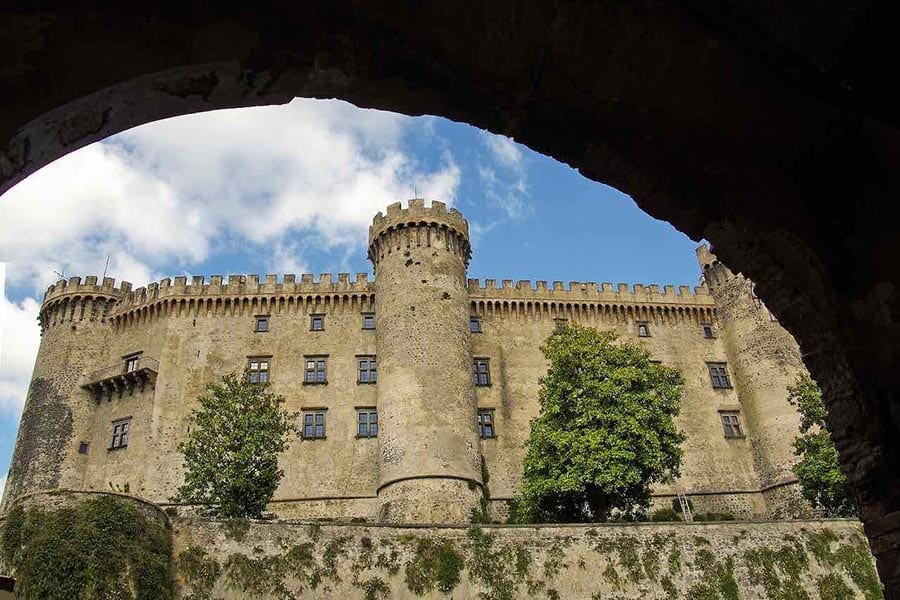
The most outstanding historical landmark in the natural area known as the Regional Park of Lake Bracciano is the Bracciano Castle. The castle dominates the lake from the historic center of the small, people-friendly city of Bracciano, which is located about 40 km north of Rome.
Known today as the Odescalchi Castle, got the current appearance after the renovation by the Orsini family during the Early Renaissance, but it is certainly much older.
After surviving through the centuries to the armed conflicts between rival noble Roman families, confiscation by the papacy and the French, the Bracciano Castle has become a museum, where more than 20 perfectly preserved rooms, with frescoes and furniture from the 15th and 16th century, can be visited independently, for €8.50.
Each room is equipped with information signs telling the history and curiosities. During the week, this place where time has stood still is often empty, it is a pleasure to visit it and linger in each room.
One of the most interesting rooms is the bedroom of Isabella De Medici, where it is said that the noblewoman received dozens of lovers. Walking on the castle walls, it is also possible to admire some of the most suggestive panoramic views of Lake Bracciano.
To reach Bracciano from Rome by public transport, take a train to Bracciano from the stations of Rome Ostiense, Trastevere, or Valle Aurelia.
YOU MIGHT ALSO LIKE: Best Castles in England
Best Castles in Southern Italy
Gallipoli Castle, Puglia
Contributed by Michele from A Taste for Travel

This impressive castle set overlooking the Ionian Sea at the entrance to Old Town Gallipoli is accessed via a bridge, built in the 16th century, from the mainland. Castello di Gallipoli is one of the most dramatic castles in Europe so spending a day exploring its history is one of the top things to do in the Salento region of Puglia, Italy.
Originally built in the 13th century by the Byzantines to protect valuable trade routes in olive oil and wine from the agriculturally rich Salentine peninsula, it was expanded over the centuries with a polygonal wall fortified with round towers.
Today, it’s possible to stand on the ramparts of the fortified walls and enjoy panoramic views of the white sand beaches lining the coast, the burnished gold-hued stone of the Baroque buildings of the old city, scenes of fisherman tending their nets in the harbour and of course, the blue waters of the Ionian Sea.
Within the interior of the Castello di Gallipoli, the soaring rooms with barrel and cross vaults are often the setting for temporary art exhibitions and photography displays while the Torre del Rivellino (tower) is used for film, concerts and dance performance events.
Other highlights include the fresco-decorated chapel, winding staircases, atmospheric courtyards and historical and cultural displays.
Hours vary seasonally. Admission is 5€ per person.
Castel del Monte, Puglia
Contributed by Nadine from Le Long Weekend

The 13th century Castel del Monte sits on a low hill in the middle of Puglia, on the ‘heel’ of Italy. Its presence is inconspicuous, and it’s located well off the usual tourist trail, and yet it holds an important part in the country’s heritage. It was named a UNESCO World Heritage Site in 1996 and you’ll even find its image imprinted on the Italian version of the 1 cent coin!
The castle has a distinctive appearance, constructed in a geometric design with an octagonal tower at each corner, making it unique among the other castles of its time. And although it is classed as a military fortress, some speculation suggests it was never intended for this purpose, as it has neither a moat nor a drawbridge.
The castle is located less than an hour’s drive from Bari – the region’s capital – so it’s an easy day trip if you’re staying along the coast. Entrance costs €7 per adult (children under 18 are free, and up to 25 just €2), but budget a few euro for parking too. You can walk around the grounds of the castle for free, admire the views and the exterior, but taking a tour of the interior is when you’ll truly appreciate the architecture of this unique castle.
Castel del’Ovo, Naples
Contributed by Anda from Travel for a While

One of the must-visit places in Naples is Castel dell’Ovo (The Egg Castle). The castle is located just by the sea, on the former Megaride island. You can see Castel dell’Ovo from anywhere along Naples Lungomare, the popular promenade by the sea.
Megaride island was the first place where Greeks started a new colony, which later became Naples, the third-largest city in Italy. It was used ever since, first as a Roman Villa, then later as fortifications to defend the city and as a castle from the end of the 15th century.
Legend says that the Roman poet Virgil placed an egg at the foundations of the fortification on the island to predict Naples’ future. That’s the reason for the castle’s unusual name.
Castel dell’Ovo is free to visit and open every day from 8:00 AM to sunset. On Sundays, the castle is only open in the morning, from 9:00 AM until noon. Just outside the castle, on its eastern side is Borgo Marinaro.
Originally a small fishing village, Borgo Marinaro became a marina but also developed into an area full of restaurants, where you’ll find some amazing fresh fish.
The island is now connected to the mainland by a causeway, making it impossible to miss while you walk by the sea and one of the top places to visit in Naples.
Best Castles on Italy’s Islands
Serravalle Castle, Bosa, Sardinia
Contributed by Claudia from Strictly Sardinia

Serravalle Castle, locally known as Malaspina, is located on the hills of Bosa, about an hour drive from Alghero, Sardinia, and thought to be one of the prettiest villages in Italy.
Built in 1112 on the Serravalle hill by the Malaspina dello Spino Secco family, at the time when this part of the island was under the control of the Judges of Arborea, the castle had mainly a defensive role. It was built in various stages and throughout time underwent several modifications. The first stage of construction, in the 12th century, consisted in the building of a tower and the northern walls.
The main tower was built in the 14th century and used to have 3 floors. Eventually, seven more square towers were added. During the 14th century a church was also built inside the Castle grounds – the Nostra Signora de sos Regnos Altos. This was decorated with beautiful frescoes – currently only partially visible – representing the lives of saint and martyrs such as St. Lawrence and St. Christopher.
Nowadays, most of the original structure of the Castle has been destroyed. The walls and the watchtowers continue providing impressive views over Bosa.
Serravalle Castle is open daily from 10:00 am to 7:30 pm. Make sure to double check the opening times by calling +39 340 395 5048 +39 329 850 507. Admission is €4 euro.
Castello di Lombardia, Sicily
Contributed by Annabel from Smudged Postcard
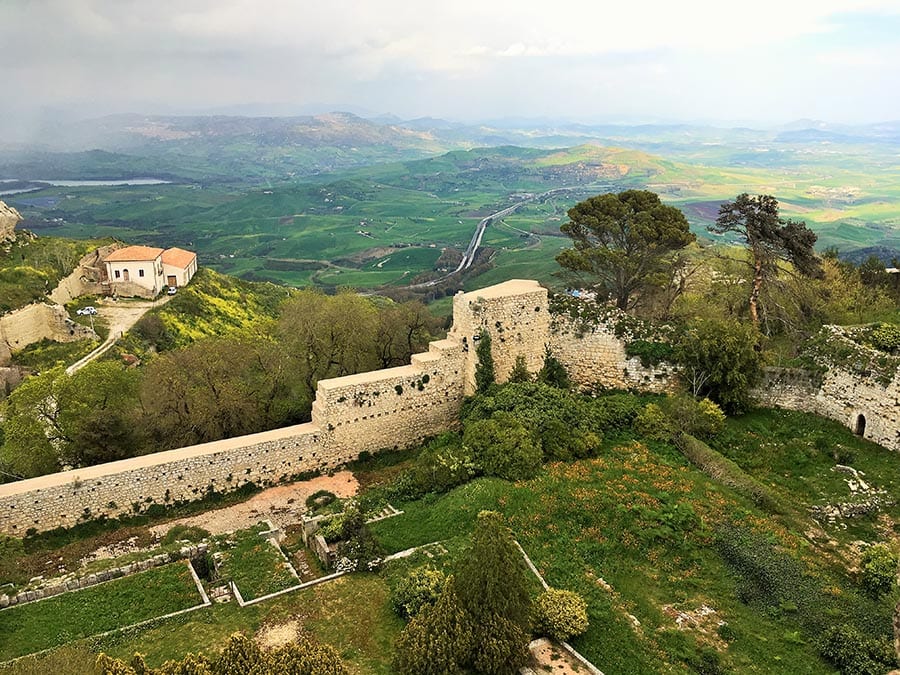
If you drive into the centre of Sicily, some 140 kilometres from Palermo and 100 kilometres from Catania, you’ll eventually reach Italy’s highest regional capital, Enna. Standing precipitously above the surrounding countryside, Enna is a fascinating city to explore. At the very top of the Enna you’ll find Castello di Lombardia, a 13th century castle.
Given its age, Lombardia is surprisingly well intact. You can climb one of its six remaining towers for incredible views over Sicily’s wheatfields which are an bright shade of green should you visit Sicily in spring.
Lombardia was built on the site of an ancient fortress which dates back some two thousand years. Over the centuries the castle has witnessed the various foreign invasions of Sicily: Greek, Roman, Arab and Norman; a useful guide to the history of the island.
The castle is free to visit and quite often you’ll have the place to yourselves. There’s a spacious grassy courtyard, alive with wildflowers in springtime. If you’re visiting Sicily with children, Castello di Lombardia is a wonderful place for kids to explore.
Castello di Lombardia is best reached by car. Enna has a limited selection of hotels so an agriturismo in the surrounding countryside is the best option if you’d like to explore the region fully. Easter is the perfect time to visit when the city holds traditional processions through the streets.
Lipari Castle, Sicily
Contributed by Emily from Wander-Lush

Located on the south-eastern tip of Lipari, one of the seven volcanic islands that make up the Aeolian Archipelago off Sicily’s west coast, Lipari Castle (Lipari Castello) is one of the most captivating castles in Italy.
The fortress walls were built in 1556 atop an ancient Greek acropolis, which in turn was erected on the foundations of an older settlement that dates back to the Neolithic age. Lipari was a trading port for obsidian and has long been coveted by invading forces, as evidenced by the castle’s many layers of history and culture.
Today, several noteworthy churches and buildings are enclosed within the castle walls. The most magnificent is Saint Bartholomew’s Cathedral, built to house Holy relics that are said to have washed ashore on the island. As you wander around the castle grounds you can see a number of open excavation sites, including the remnants of the Greek necropolis and a reproduction of the Greek theatre that once stood here.
The castle’s crowning jewel is the Archaeological Museum of Lipari. A must-visit when island hopping in the Aeolian Archipelago, it’s a world-class institution that displays relics unearthed during the digs, including a collection of hundreds of clay amphora, various coins and jewellery.
When visiting the castle, don’t forget to walk around the back for a spectacular aerial view of the harbour below. The best views of the castle itself are from the nearby Piazza Marina Corta, which houses most of Lipari town’s best restaurants and cafes.
The castle is walking distance from the main marina, which is serviced by regular ferries from the other islands and the Sicilian mainland. The grounds are free to enter; tickets for the museum cost 6 Euro.
Castello Maniace, Sicily
Contributed by Annabel from Smudged Postcard

Castello Maniace is located at the very edge of Ortigia in the city of Syracuse in Sicily. Ortigia is the historical heart of Syracuse and is surrounded by sea, joined to mainland Sicily by two bridges.
Ortigia is small and so you can easily reach Castello Maniace on foot along the narrow medieval lanes of the city (ensure you stop for a coffee in the Piazza Duomo on route). Overlooking the sea, Castello Maniace is the perfect fortification against seaborne invaders of which there have been many in Sicily’s long and turbulent history.
Although the origins of Castello Maniace are Greek, the current structure was built in the 13th century by Emporer Frederick II. Part royal residence and part defensive fortress, Castello Maniace is a warren of stone tunnels and atmospheric rooms, with windows offering glimpses of the waves lapping the castle walls.
If you’re visiting Syracuse with kids, the castle is the perfect playground where children can play at being knights, princesses and pirates all in one setting. There’s a small charge to enter the castle and it is usually fairly quiet. Ensure you spend at least one night in Syracuse to fully appreciate the beauty of the city. Syracuse is around an hour from the international airport at Catania.
Map of the Best Castles in Italy
I hope you like this tour around some of the best castles in Italy. Do you have a favourite? Let me know in the comments below.
Don’t forget to pin this article so you can come back to it later

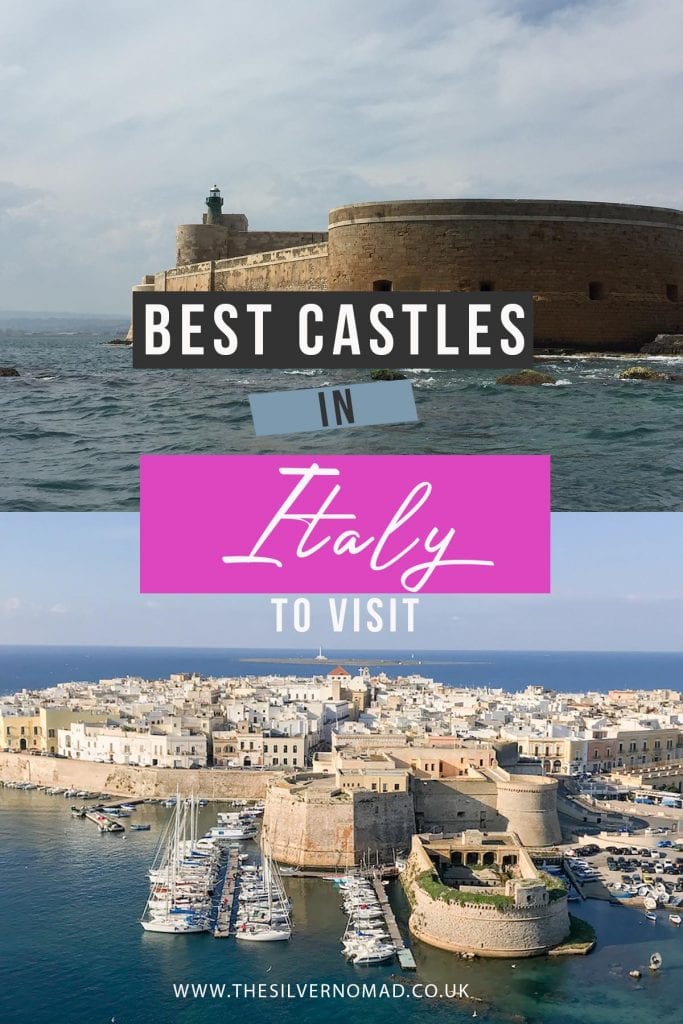
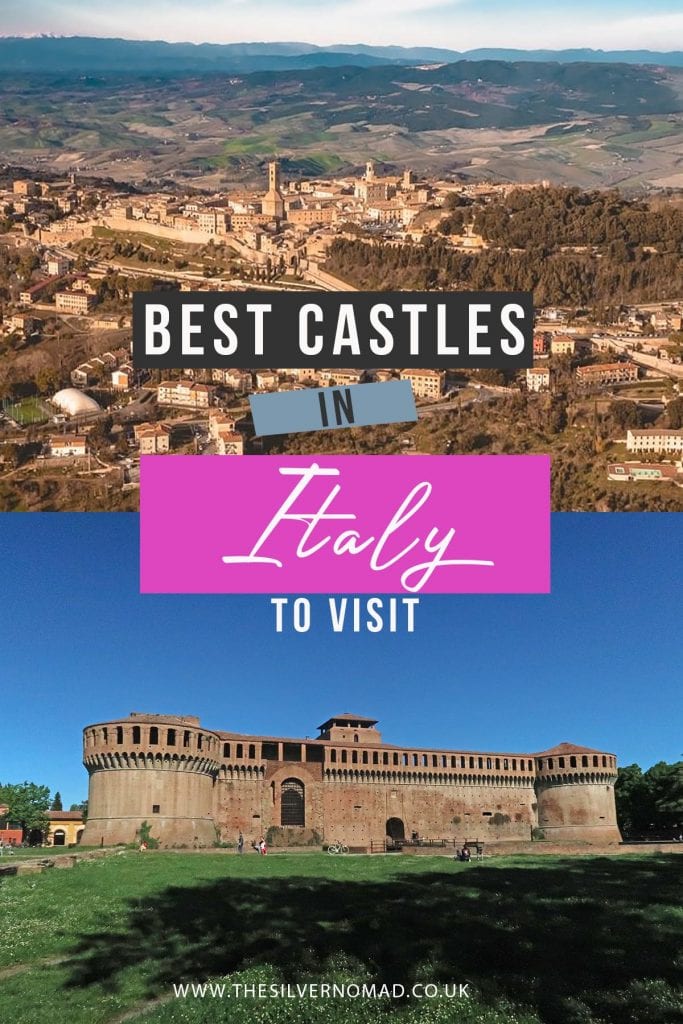
Use these Italy Travel Tips to plan your adventure!
- Plan your trip with these Italy Travel Guides .
- Get the best deals on flights with Skyscanner .
- Find the perfect place to stay in Italy on Booking.com .
- Explore more about Italy with local experiences.
- Don’t forget to arrange your travel insurance .
- Learn Italian with an Intrepid Italian Course .

Great list. I’m into all things related to Italy and I love castles, so saving this post for future reference, grazie ????
Prego, I hope you get to see them soon.
Castles are my favourite thing to visit while I’m travelling – and this list is making me want to book a flight to Italy ASAP!
I hope you get there to visit them.
THAT is a lot of castles! I love learning about the heritage and history of other countries. Thanks for the details and the map. So great.
Thank you Margarita, I hope you get to see some of them.
I have been multiple times to Italy but I haven’t visited any of these castles. I would love to return and visit them, especially the Miramare Castle in Trieste.
The Miramare is stunning, I do hope you get to see it.
All of these castles in Italy look so majestic! I need to add them all to my bucket list.
I have such a massive bucket list!